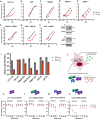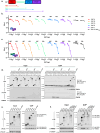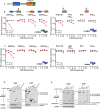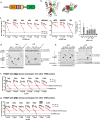Functional anatomy of zinc finger antiviral protein complexes
- PMID: 39738020
- PMCID: PMC11685948
- DOI: 10.1038/s41467-024-55192-z
Functional anatomy of zinc finger antiviral protein complexes
Abstract
ZAP is an antiviral protein that binds to and depletes viral RNA, which is often distinguished from vertebrate host RNA by its elevated CpG content. Two ZAP cofactors, TRIM25 and KHNYN, have activities that are poorly understood. Here, we show that functional interactions between ZAP, TRIM25 and KHNYN involve multiple domains of each protein, and that the ability of TRIM25 to multimerize via its RING domain augments ZAP activity and specificity. We show that KHNYN is an active nuclease that acts in a partly redundant manner with its homolog N4BP1. The ZAP N-terminal RNA binding domain constitutes a minimal core that is essential for antiviral complex activity, and we present a crystal structure of this domain that reveals contacts with the functionally required KHNYN C-terminal domain. These contacts are remote from the ZAP CpG binding site and would not interfere with RNA binding. Based on our dissection of ZAP, TRIM25 and KHNYN functional anatomy, we could design artificial chimeric antiviral proteins that reconstitute the antiviral function of the intact authentic proteins, but in the absence of protein domains that are otherwise required for activity. Together, these results suggest a model for the RNA recognition and action of ZAP-containing antiviral protein complexes.
© 2024. The Author(s).
Conflict of interest statement
Competing interests: The authors declare no competing interests.
Figures








References
Publication types
MeSH terms
Substances
Associated data
- Actions
- Actions
- Actions
- Actions
Grants and funding
LinkOut - more resources
Full Text Sources

